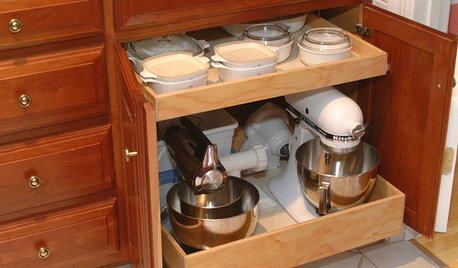Second Betta not eating! First one died! :(
cuzsis
17 years ago
Related Stories

MOST POPULAROrganizing? Don’t Forget the Essential First Step
Simplify the process of getting your home in order by taking it one step at a time. Here’s how to get on the right path
Full Story
MOST POPULARFirst Things First: How to Prioritize Home Projects
What to do when you’re contemplating home improvements after a move and you don't know where to begin
Full Story
LIFESo You're Moving In Together: 3 Things to Do First
Before you pick a new place with your honey, plan and prepare to make the experience sweet
Full Story
KITCHEN DESIGN10 Kitchen Setups for an Eating Area You’ll Love
Bring color and creativity to the table with cool chairs, statement lighting and artful touches
Full Story
HEALTHY HOME12 Ways to Set Up Your Kitchen for Healthy Eating
Making smart food choices is easier when your kitchen is part of your support team
Full Story
KITCHEN DESIGNHouzz Call: Tell Us About Your First Kitchen
Great or godforsaken? Ragtag or refined? We want to hear about your younger self’s cooking space
Full Story
KITCHEN APPLIANCESConsidering a New Kitchen Gadget? Read This First
Save money, time and space by learning to separate the helpers from the hassles
Full Story
MOST POPULARArchitectural Icon: The World’s First Bauhaus House
The Haus am Horn in Weimar is the first architectural example from the famed school, and the only one in the German city where Bauhaus began
Full Story
HOME INNOVATIONSConsidering Renting to Vacationers? Read This First
More people are redesigning their homes for the short-term-rental boom. Here are 3 examples — and what to consider before joining in
Full Story
LIFE10 Ways to Honor and Remember a Departed Loved One at Home
Help the grieving process and keep beautiful memories alive with these thoughtful tributes
Full StorySponsored






petiolaris
cuzsisOriginal Author
Related Professionals
Havre de Grace Landscape Architects & Landscape Designers · Winder Landscape Architects & Landscape Designers · Bethlehem Landscape Contractors · Pottstown Landscape Contractors · Gaithersburg Landscape Contractors · Hickory Hills Landscape Contractors · National City Landscape Contractors · Riverview Landscape Contractors · South Lake Tahoe Landscape Contractors · Southbury Landscape Contractors · Asheville Decks, Patios & Outdoor Enclosures · Kearns Decks, Patios & Outdoor Enclosures · Rantoul Decks, Patios & Outdoor Enclosures · South Lyon Decks, Patios & Outdoor Enclosures · South Milwaukee Decks, Patios & Outdoor Enclosurespetiolaris